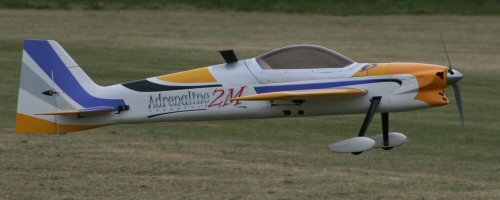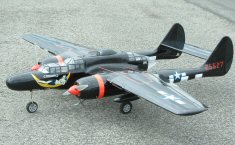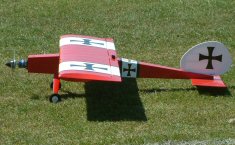|
|||
|
|
|
||
| View Shopping Cart |
| Home |
| Guides Available |
| About the Author |
| FAQs |
| Testimonials |
| Articles |
| Contact Andrew |
| Terms & Conditions |
| Mailing List |
| Links |
 |
 |
Get more great
articles like this one absolutely free with every
Gibbs Guides e-magazine. Join
the mailing list!
How To Land An RC Model
Part 3: The Touchdown - Tricycle and Taildragger techniques
Article by Andrew Gibbs

The previous two parts of this article have brought us to the point where the model is at the moment of touch down. Nevertheless, once the wheels have made contact with the ground, the landing is far from over, especially if the model is a taildragger.
The essential issue is the location of the model's wheels in relation to its center of gravity (CG). The location of the gear has an important effect on whether the model is inherently stable, or unstable while on the ground. This is important because there are many destabilizing influences on the model, such as the effects of the propeller and bumps in the runway.
In the case of the nose gear equipped model, the CG is in front of the main wheels. If a yaw, or swing develops, all the wheels will naturally resist this movement, and consequently the model is inherently stable while on the ground.
Conversely, a tail wheel equipped model has its wheels in front of its CG, making the model inherently unstable on the ground. Simplifying the situation, consider for example the case where a taildragger, with its tail up, develops a slight yaw, or swing, say to the left. The model can freely pivot about its main gear wheels, and they do nothing to prevent the yaw developing further. Momentum will tend to carry the CG further to one side, making the situation worse. If nothing is done to correct the yaw, it may become rapidly worse, the rate so much so that the model may describe a circle on the ground. This is known as a ground loop.
If the model is resting on its tail the situation is only a little better - because the tail wheel supports only a small proportion of the model's weight, it has little ability to resist the yaw.
| The center of gravity of a conventional model lies in front of the main gear wheels (click small images to enlarge). | The center of gravity of a taildragger is always behind the main gear wheels. This makes for inherently unstable ground handling (click small images to enlarge). |
How to handle the different types
The configuration of the gear makes no difference while the model is airborne,
but it becomes all-important as soon as contact with the ground is involved.
Let's have a look at the different handling techniques required of each
type of gear:
Nose gear handling technique
Conventional gear gives a model easiest ground handling, both during take
off and landing.
For models with nose gear, once the main wheels have made contact with the runway, you should fully close the throttle if you have not already done so, and gently ease off the up elevator to neutral to allow the nose wheel to make contact with the ground. Lowering the nose also means that the angle of attack of the wing is reduced, which will help stop the aircraft becoming airborne again. Maintain directional control with rudder, and allow the model to come to a stop.
Its fine to leave the elevator in the neutral position after the nose has been lowered. However, if you wish, once the model has slowed to well below flying speed, you can re-apply a little up elevator in order to reduce the load on the nose leg. You should avoid using down elevator as this will load up the nose gear leg unnecessarily.
Taildragger handling technique
Taildragger's are significantly more demanding to land, due to the lack
of directional stability. This requires the pilot to be vigilant to keep
the model tracking straight while it's on the ground. Taildragger's can
easily ground loop if they are not kept tracking straight.
A slightly different technique is required to land a taildragger. In fact, there are two possible techniques; the 'wheeler' method, and the 'tail down' method.
(a) The wheeler method
The wheeler method involves touching down with the taildragger's main
wheels first, with the model in less of a nose high attitude. The lower
nose attitude means the model will be flying a little faster and will
thus be further away from stalling, which is of course somewhat safer.
Once the main wheels have made contact with the ground, maintain the elevator position, and keep the model straight with rudder. As the model slows the tail will naturally, gently drop down. Once the tail wheel or skid makes contact with the ground, the model should be well below flying speed and so you can then bring the elevator stick all the way back to full up elevator. This will help to keep the tail on the ground, aiding directional control. Keep the model straight with rudder until it has come to a full stop.
(b) The tail down method
The tail down method involves the model being slowed sufficiently during
the hold off that it touches down in a nose high, 'three point' attitude
- in other words, all three wheels touch down at more or less the same
moment. This is known as a three point landing.
To achieve this, the model has to be flying in quite a nose high attitude at the moment of touch down, which means that it will be at a speed only just above the stall. In the world of full size aviation, the expert taildragger pilot will use the tail down technique only if the prevailing wind conditions are favorable.
However, the tail down technique is not generally so suitable for model flying because flight very near the stall means that the risk of damage to the model will be considerably higher than if the wheeler landing technique is used. For this reason, until you become very familiar with your model, and the conditions are suitable, I recommend the wheeler method.
Taildragger's need attention at all speeds
There is a saying in full size taildragger flying, which is that a taildragger,
the landing is not over until the airplane is actually stationary. This
is because the fundamentally unstable nature of the taildragger means
a ground loop is a possibility at pretty much any speed. This saying can
be said to apply equally to our models!

